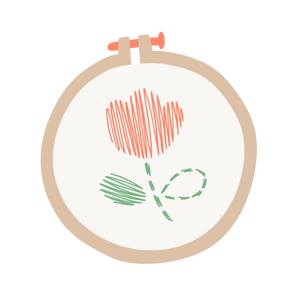Fast & tracked delivery
Your dose of creativity arrives quickly at your home, you can track your package right to your mailbox.

Are you just starting out or looking to save time? The amigurumi kits offered by JOY! contain everything you need to get started easily: suitable yarn, crochet hook, batting, illustrated tutorial... Simply choose the stuffed animal you want to create.
See all amigurumi kitsStuffing is the often underestimated yet essential step in making a successful amigurumi ! Whether you're crocheting a cute little panda, a plump cactus, or a magical unicorn, good stuffing makes all the difference: the plush toy keeps its shape, is soft without being mushy, and sits comfortably in the hand... or even stands up if necessary.
Poorly stuffed stuffing, on the other hand, can give an unstable result: visible bumps, overly tight stitches, sagging limbs... and sometimes, a disappointing result despite all the care taken with the crochet.
There isn't just one good upholstery, but several options depending on your needs and the desired result. Here are the most commonly used:
This is the most common stuffing. Lightweight, fluffy, easy to handle, and washable, it's perfect for beginners. It's easily found in haberdashery stores or online.
💡 At JOY!, this is the wadding we use in most of our amigurumi kits: it allows us to fill each shape well, without creating a bump.
These plant or animal fibers are a more natural alternative. Kapok is very lightweight, and wool retains heat well. However, they are more compact and less elastic, so the result is denser.
Zero-waste solution! Ideal for firm areas (e.g., the bottom of a sitting amigurumi). Simply cut into small pieces and alternate with a bit of cotton wool to avoid lumps.
Perfect for stabilizing a base (making a dinosaur stand upright, for example), or giving a plush toy a "weight" effect. Use in small quantities, often in a sewn sock or a small bag.
A good filling is similar to a good cake batter: not too dense, not too airy, but well distributed and even! Follow these simple steps:
Never put the cotton wool in your amigurumi in a big pile! You must:
💡 JOY Tip!: If you have an old cushion or tired stuffed animal, you can recycle the wadding as long as you air it well.
It is better to pad gradually than all at once:
This allows for better volume control and adjustment according to the shape of the piece (e.g. rounded belly or head).
For arms, ears, or other small shapes, your fingers won't be enough. Use:
➡️ This allows you to gently push the cotton wool to the bottom , without packing it down too tightly.
Between each addition of stuffing, lightly knead the amigurumi between your hands :
🧡 Remember to check for asymmetry: an overly swollen ear or a dangling arm can be seen quickly...
Final goal: the amigurumi should be firm to the touch , but without bursting the stitches .
✔ Too little = saggy effect, fluff that sags.
✔ Too full = stretched stitches, visible holes, stuffing sticking out.
You should be able to press lightly on the shape without it crushing… or resisting like a tennis ball.
Some parts of an amigurumi require a little more patience and precision. But rest assured: with the right techniques, everything becomes easier.
These pieces are small, sometimes closed on one side only... and can easily become deformed if poorly padded.
Here are our tips:
💡 JOY Tip!: If you're using safety eyes, remember to pad around them before attaching them. This prevents the area from being hollowed out once the eye is in place.
Certain structures can unbalance the padding if not anticipated. For example:
✅ What to do:
To make an amigurumi stay in place, you can:
🎯 These tips are particularly useful for poseable models (sitting panda, standing cat, dinosaur, etc.).
Here are the most common mistakes when stuffing amigurumi, and how to avoid them effectively:
| Part to be padded | Recommended quantity | Specific advice |
|---|---|---|
| Head | Firm but flexible | Fill in layers and smooth often for a nice round shape |
| Body | Firm and dense | Pad the base more for stability; smooth in the center |
| Arms / Legs | Soft to semi-firm | Use small pieces, do not overfill to make assembly easier |
| Ears / Tail | Very light or without padding | Add just a cloud to hold the shape without stiffening |
| Base (to hold the amigurumi) | Compact or lightly weighted | Add microbeads or more density in the lower body |
The ideal stuffing material for amigurumi is polyester wadding. It's lightweight, soft, easy to handle, and machine washable. It provides even, lump-free padding while maintaining a soft feel. Other materials like kapok or natural wool are also available, but they produce a denser finish.
Raw cotton can be used, but it is stiffer, heavier, and less elastic than polyester wadding. It produces a firmer, even rigid, filling suitable for stable or decorative amigurumi. For a softer, lighter effect, synthetic wadding is preferable.
The magic circle technique allows you to start an amigurumi without leaving a hole in the center of the piece (often used for the head or body). It's a solid base that prevents gaps through which the stuffing could leak. It also ensures a more consistent shape from the start.
The choice of crochet hook directly impacts the stuffing. It is recommended to use a crochet hook smaller than the size recommended for the chosen yarn. This allows for a tighter mesh, which will hold the stuffing securely inside. A crochet hook that is too large will make the stitches loose and reveal the wadding.
Yes. The larger the amigurumi, the more structured and gradual stuffing it requires to maintain its shape. Smaller amigurumis, on the other hand, require lighter, more precise filling, with very small amounts of evenly distributed fiberfill.
Once the stuffing is complete, it's recommended to smooth the shapes, check for symmetry, and then move on to decorating. This can include embroidery (nose, mouth, cheeks), accessories (scarf, hat), or safety eyes. Proper stuffing helps ensure a clean and balanced finish.
To assemble the different parts of an amigurumi, it is recommended to use a wool needle and sew with the same yarn as the crochet hook. Care must be taken not to move the stuffing too much when sewing. The trick is to assemble the pieces in a discreet spiral while maintaining the shape with your fingers.
The face is usually embroidered after stuffing , to fit the final shape. It is advisable to use a contrasting thread and an embroidery needle. Start by positioning the markers (pins or erasable marker), then embroider in small, taut stitches, without pulling too hard so as not to distort the surface.
Yes, using more compact materials than traditional wadding, such as tightly packed fabric scraps, raw cotton, or even a rigid interior structure (wire, stick, pipe cleaner). This type of stuffing is useful for decorative amigurumi or pieces that need to stand on their own.
Commodo lorem morbi aliquam dui turpis. Iaculis pretium poses nulla tincidunt blandit. A at elementum faucibus integer.

Your dose of creativity arrives quickly at your home, you can track your package right to your mailbox.

Got a problem? Don't panic, you have 15 days to change your mind.

Creative activities for young and old (from 0 to 77 years old!), perfect for disconnecting from screens and spending real time together.

JOY! is fun, colorful, and a touch of madness to dust off your creative leisure activities!
